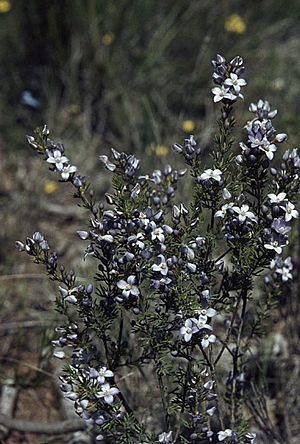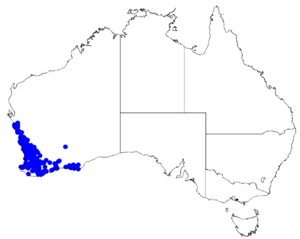Boronia ramosa facts for kids
Quick facts for kids Boronia ramosa |
|
|---|---|
 |
|
| Boronia ramosa near Bindoon | |
| Scientific classification | |
| Genus: |
Boronia
|
| Species: |
ramosa
|
 |
|
| Occurrence data from Australasian Virtual Herbarium | |
| Synonyms | |
|
Cyanothamnus ramosusLindl. |
|
Boronia ramosa is a special type of plant that belongs to the citrus family, called Rutaceae. You can only find it growing naturally in the southwest part of Western Australia. It's a straight, mostly smooth bush with leaves that look like feathers, having up to seven small parts called leaflets. Its flowers are white with four petals, and they often have blue or light green on the back.
Contents
What Does Boronia ramosa Look Like?
Boronia ramosa is a thin, straight, woody bush. It usually grows to about 30 centimeters (12 inches) tall. It's mostly smooth, meaning it doesn't have much hair on its stems or leaves.
Its leaves are special because they are pinnate. This means they have smaller leaf parts, called leaflets, arranged along a central stem, like a feather. Each leaf is about 10 to 30 millimeters (0.4 to 1.2 inches) long and has between three and seven leaflets. These leaflets are about 5 to 15 millimeters long.
The flowers of Boronia ramosa grow in groups of up to three where the leaves meet the stem. Each flower has a small stalk, called a pedicel, that is 2 to 15 millimeters long. The four sepals (which are like small leaves that protect the flower bud) are thick, smooth, and egg-shaped, about 1.5 to 5 millimeters long.
The petals are white and have blue or light green on their backs. They are broadly oval-shaped and about 3 to 5 millimeters long. You might notice they have small glands, which are like tiny bumps. This plant usually flowers from May to October.
How Boronia ramosa Got Its Name
This plant was first officially described in 1839 by a scientist named John Lindley. He first called it Cyanothamnus ramosus. Later, in 1863, another scientist, George Bentham, changed its name to Boronia ramosa.
The second part of its name, ramosa, comes from a Latin word that means "full of branches." This name fits well because the plant often has many branches.
Scientists have also identified three different types, or subspecies, of Boronia ramosa. These subspecies have small differences, like the length of their flower stalks or the shape of their leaflets:
- Boronia ramosa subsp. anethifolia: This type has short flower stalks (2-3 mm long) that are shorter than its leaves. Its leaflets are round and have a groove on the top.
- Boronia ramosa subsp. lesueurana: This type also has short flower stalks (2-3 mm long) that are shorter than its leaves. Its leaflets are narrow and curved inwards on the top.
- Boronia ramosa subsp. ramosa: This type has longer flower stalks (6-15 mm long) that are longer than its leaves.
Where Boronia ramosa Grows
You can find Boronia ramosa growing on slopes and hillsides in the southwest part of Western Australia. Sometimes, it even grows in old gravel pits. It's found in a wide area, from near Shark Bay all the way to Esperance.
Each subspecies tends to grow in specific areas:
- Subspecies anethifolia is found between the Murchison River, the Stirling Range, and Cape Le Grand.
- Subspecies lesueurana is only known from near Mount Lesueur.
- Subspecies ramosa mainly grows in the Darling Range.
Is Boronia ramosa Endangered?
The Western Australian Government's Department of Parks and Wildlife has looked at Boronia ramosa. They have decided that it is "not threatened," which means it is not currently in danger of disappearing.

